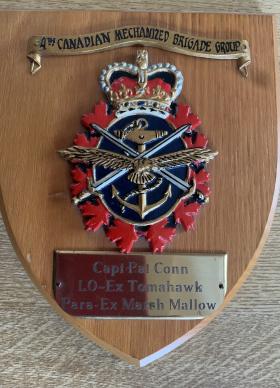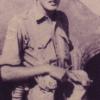Exercise Tomahawk was an exercise in the second half of 1969 which was a precursor to the larger Exercise Marshmallow. Like the latter, it involved 15 PARA SV combined with the 4th Canadian Mechanized Brigade Group against a force from I Corps. Tomahawk was largely used to plan and prepare for Marshmallow and was organised with the help of 15 PARA's adjutant, Pat Conn, in concert with the CO, Brigadier Joe Starling. Pat's account of Tomahawk follows.
Exercise Tomahawk
The first point to make is that I, as the Adjutant of 15 PARA, was sent ahead by the CO, Joe Starling, after his initial recce, to be attached to HQ 4 CMBG as a Liaison Officer, really to see how the Brigade Group ticked and to learn their procedures. It would culminate in Ex Tomahawk in Soest and Bavaria as a work up for Marshmallow. I was also to coordinate with HQ 1 (BR) Corps. I was sent to talk to General `Tubby’ Butler, who stressed that he wanted his Corps to be stretched, and if we wanted to` play dirty’ so be it!
With this in mind, I reported back to Major Andy Christie then the Brigade Chief of Staff (later he commanded a Canadian Airborne Regiment and went onto become Major General Canadian Forces), and asked what Canadian aircraft he had at his disposal. He told me a handful of Hercules and a load of Buffalos! I had been asked by Colonel Joe to try to get the use of Canadian rather than RAF aircraft for Marshmallow to preserve security.
Andy said he would get a gaggle of Buffalos for us; the downside is that we had to have RAF clearance for our parachutes and equipment. This resulted in two aircraft being positioned, one at RAF Abingdon, the other at RAF Turnhouse (Edinburgh) for aircraft drill mods. Once sorted these aircraft would then operate out of Abbotsinch (Glasgow Airport), Dyce (Aberdeen Airport) and Turnhouse ((Edinburgh). This was for the para soldier aircraft conversions, and they also had to include umpire teams. In the end Canadian Hercules and Buffalos were used with Canadian crews and Loadmasters but with RAF dispatchers. At the end of all this 15 PARA received a massive bill for parking landing and refuelling bills from these airports. The Command Secretary HQ Scotland refused us permission to pay, but fortunately HQ 44 PARA Bde stepped in with HQ STRATEGIC Command in support, and I sent off some extremely large cheques from the Imprest Account to clear the bills.
I worked as a fulltime ops/watchkeeper in the armoured Brigade HQ and got quite used to their radios, M113 carriers, and similar but never really mastered the French-Canadian accents of the Royal 22nd Regiment (Vingt-Doux). What was impressive is that every unit changed its shape, name, organisation, tactics and attitude to that of the Orange Army for a whole month prior to Marshmallow, although SOPs remained Canadian. It was total immersion. They practiced moving in radio silence in all types of country and weather and well as with minimum radio operations using hand and coloured light signals. Very impressive…and the food and its quantities were spectacular!
The Brigade Group had its own integral helicopter regiment, Mainly CUH-1N Twin Huey. This meant that you could whistle up a squadron of say 10 helicopters which was an 80-100 man lift. The Mechanised Brigade Group also understood airborne and airmobile operations because of one of its quirks. In 1958 the "Mobile Strike Force" was restructured as "The Defence of Canada Force", resulting in a reduction to one parachute company in each battalion. At this time the airborne artillery was disbanded, and other support elements reduced. The parachute component in each battalion consisted of battalion tactical headquarters, and a large company group (i.e. four platoons) with support detachments of mortars, machine guns, pioneers and reconnaissance detachments. A large reserve of trained parachutists was built up in the other companies. In 1968, many of the officers and soldiers of the "Defence of Canada Force" provided the nucleus of expertise for the new Canadian Airborne Regiment.
As a Mechanised Brigade Group they had Leopard as their MBT, Lynx as their recce and M113 family as their carriers. Their artillery if I can recall was the M109 155mm SP Howitzer as well as a gun-based air defence regiment (35mm Oerlikons I seem to remember). The whole formation struck me as being a light division but highly mobile and the Commander was a` tankie’ with determination and flair.
The final point which I have to make relates to my visit to HQ 1 (BR) Corps in Bielefeld. It was clear from my short chat with General Sir Mervyn Butler that he needed to shake up complacency both in his staff as well as in his armoured divisions and he wanted surprises if we could manage it. I discussed things with Andy Christie and had a chat with Col Joe and came up with a form of deception plan, or at least an attempt of `maskirovka’ and it worked. It was apparent that Corps staff were confident than any airborne threat would be quickly neutralised because of the requirement for the NOTAM actions well before the drops which would give away DZ locations. Joe’s answer was swift, work out as many alternative DZs with Andy as I can which would be tactically sensible and dimensionally feasible using peacetime criteria. I think we came up with 34 or 37 different locations. NOTAM plan was put in place and HQ 4 CMBG would contact Corps HQ for clearances. The actual DZs were not released to Corps…and it worked. 15 Para were dropped in company groups at last light at the three well-known choke points of Springge, Rodenberg and Coppenbrugge using USAF Hercules and Buffalo. One drop was aborted because of fog. Furthermore, the airlift was mounted out of Gütersloh which was the nearest RAF airfield to the EAST/WEST border. Maskirovka worked with a double bluff because Corps were sure that being TA 15 PARA would mount form the UK and thus eyes were focussed for air movement that way and also the actual DZs were not compromised by the blanket NOTAM action. Another outcome of Tomahawk was that Colonel Joe wanted everyman to be a potential tank killer. With this in mind, 15 PARA `borrowed’ several hundred 66mm M72 LAW from the US and Canadians to represent RPGs. These were a triumph!
In summary, Tomahawk enabled the `Orange Enemy’ to plan, understand how all the moving parts meshed, obtained a `neutral’ airlift and optimised deception. Prior to the exercise and as a part of Tomahawk `work-up’, 15 PARA was moved to Germany and based in Sennelager. Joe had permission to `lockdown’ the camp prior to Marshmallow for security. To add to Corps chagrin, a group of Gunners rocked up with their radios and vehicles and demanded accommodation saying they were a `Nuclear Escort Party’ . Hmm…that didn’t work; into the cells they went amidst threats and curses directed towards our Jock Provost Sgt and some ugly Glaswegian mates, NODUFF or not, it did not work. I took the locked briefcase from the officer, relieved him of the `combination’ for his wrist lock, and presented them to Joe, He grinned, opened them up then said they are `pukka’ and then got on to the secure phone to inform Corps HQ that their nuclear codes had been compromised. Yippee, that went down a storm. We were about to move out, so our friendly local German Feldjäger (Military Police) agreed to hold them for 24 hrs until the Exercise Marshmallow was underway.
Source:
Compiled with information from:
Account of Exercise Tomahawk kindly supplied by Walker 'Pat' Conn.
This article is currently under development
Read More





Latest Comments
There are currently no comments for this content.
Add Comment
In order to add comments you must be registered with ParaData.
If you are currently a ParaData member please login.
If you are not currently a ParaData member but wish to get involved please register.